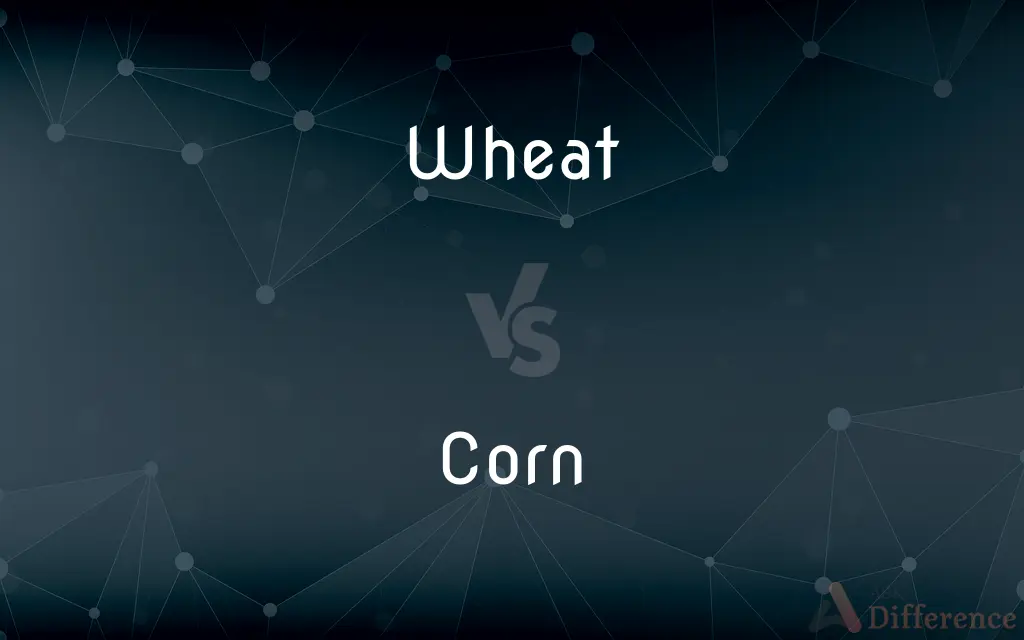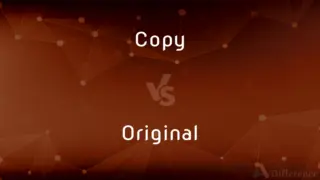Wheat vs. Corn — What's the Difference?
By Tayyaba Rehman & Fiza Rafique — Updated on September 19, 2023
Wheat is a cereal grain for bread, pasta, and pastries. Corn, also known as maize, is a versatile grain used in various forms like cornmeal, corn syrup, and as a vegetable. Both staple crops differ in their uses, nutritional profiles, and conditions.

Difference Between Wheat and Corn
Table of Contents
ADVERTISEMENT
Key Differences
Wheat is a cereal grain that is a staple in many diets around the world, commonly used for making products like bread and pasta. Corn, or maize, is another staple crop but is generally more versatile; it's used not just for cornbread but also as a vegetable, animal feed, and even for ethanol production. Both grains are foundational in agriculture, but their uses can vary considerably.
When it comes to nutritional content, wheat is rich in protein and fiber, making it a popular choice for bread and cereals. Corn, although also nutritious, offers different health benefits, including higher levels of antioxidants and a different set of vitamins and minerals. Both grains can contribute to a balanced diet, but they provide different nutrients.
Wheat is generally grown in temperate zones and has a lower tolerance for extreme weather conditions compared to corn. Corn prefers warmer climates and is generally more drought-resistant. Thus, you'll find wheat fields in cooler regions, while corn is more likely to be grown in hotter areas.
Wheat is often processed into flour, which serves as the base for many baked goods. Corn, on the other hand, can be consumed in a variety of forms, from fresh corn on the cob to processed forms like cornmeal and corn syrup. The processing methods for each grain also differ, reflecting their diverse applications.
In summary, while both wheat and corn are staple grains, they differ significantly in their uses, nutritional profiles, and ideal growing conditions. Wheat is primarily used in bread and similar products, whereas corn has a broader range of applications, including use as a vegetable and in industrial products.
ADVERTISEMENT
Comparison Chart
Primary Uses
Bread, pasta, pastries
Cornmeal, syrup, vegetable
Nutritional Profile
Rich in protein and fiber
Higher in antioxidants
Growing Conditions
Temperate climates
Warmer, more drought-resistant
Processing
Often made into flour
Consumed in various forms
Versatility
Less versatile
More versatile
Compare with Definitions
Wheat
Wheat is a cereal grain used predominantly for baking.
Wheat flour is essential for making bread.
Corn
Corn is a versatile grain used in multiple forms.
Cornmeal is made by grinding dried corn.
Wheat
Wheat is commonly grown in temperate regions.
Wheat fields are a common sight in cooler climates.
Corn
Corn is used in industrial applications like ethanol production.
Corn ethanol is an alternative to fossil fuels.
Wheat
Wheat is rich in protein and fiber.
Many people consume wheat for its nutritional value.
Corn
Corn is often eaten as a vegetable when fresh.
Corn on the cob is a popular summer treat.
Wheat
Wheat is often a primary ingredient in pastries and cereals.
Breakfast cereals often contain whole-grain wheat.
Corn
An ear of this plant.
Wheat
Wheat is a grass widely cultivated for its seed, a cereal grain which is a worldwide staple food. The many species of wheat together make up the genus Triticum; the most widely grown is common wheat (T. aestivum).
Corn
Corn is grown in warmer climates and is drought-resistant.
Cornfields are abundant in the American Midwest.
Wheat
A cereal which is the most important kind grown in temperate countries, the grain of which is ground to make flour for bread, pasta, pastry, etc.
Corn
Corn can be processed into sweeteners like corn syrup.
Corn syrup is a common ingredient in soft drinks.
Wheat
Any of various annual cereal grasses of the genus Triticum of the Mediterranean region and southwest Asia, especially T. aestivum, widely cultivated in temperate regions in many varieties for its commercially important edible grain.
Corn
A cone-shaped and often painful inwardly directed callus of dead skin that forms at a pressure point near a bone, or on a weight-bearing part of the body.
Wheat
The grain of any of these grasses, ground to produce flour used in breads, pasta, and other foods.
Corn
The chief cereal crop of a district, especially (in England) wheat or (in Scotland) oats
Fields of corn
Wheat
(countable) Any of several cereal grains, of the genus Triticum, that yields flour as used in bakery.
Corn
Something banal or sentimental
The film is pure corn
Wheat
(uncountable) A light brown colour, like that of wheat.
Corn
A small, painful area of thickened skin on the foot, especially on the toes, caused by pressure.
Wheat
Wheaten, of a light brown colour, like that of wheat.
Corn
Any of numerous cultivated forms of a widely grown, usually tall annual cereal grass (Zea mays) bearing grains or kernels on large ears.
Wheat
A cereal grass (Triticum vulgare) and its grain, which furnishes a white flour for bread, and, next to rice, is the grain most largely used by the human race.
Corn
The grains or kernels of this plant, used as food for humans and livestock or for the extraction of an edible oil or starch. Also called Indian corn, maize.
Wheat
Annual or biennial grass having erect flower spikes and light brown grains
Corn
Chiefly British Any of various cereal plants or grains, especially the principal crop cultivated in a particular region, such as wheat in England or oats in Scotland.
Wheat
Grains of common wheat; sometimes cooked whole or cracked as cereal; usually ground into flour
Corn
A single grain of a cereal plant.
Wheat
Wheat can be processed into different forms like flour and bran.
Wheat bran is a byproduct of milling wheat for flour.
Corn
A seed or fruit of various other plants, such as a peppercorn.
Corn
Corn snow.
Corn
(Informal) Corn whiskey.
Corn
(Slang) Something considered trite, dated, melodramatic, or unduly sentimental.
Corn
A horny thickening of the skin, usually on or near a toe, resulting from pressure or friction. Also called clavus.
Corn
To cause to form hard particles; granulate.
Corn
To season and preserve with granulated salt.
Corn
To preserve (beef, for example) in brine.
Corn
To feed (animals) with corn or grain.
Corn
To form hard particles; become grainy
"After the snow melts all day, it corns up at night for fine conditions" (Hatfield MA Valley Advocate).
Corn
Any cereal plant (or its grain) that is the main crop or staple of a country or region.
Corn
Maize, a grain crop of the species Zea mays.
Corn
A grain or seed, especially of a cereal crop.
He paid her the nominal fee of two corns of barley.
Corn
A small, hard particle.
Corn
(uncountable) A type of granular snow formed by repeated melting and refreezing, often in mountain spring conditions.
Corn
Bullets, ammunition, charge and discharge of firearms
Corn
Money.
Corn
A type of callus, usually on the feet or hands.
Corn
(countable) inflammatory disease of horse hoof, at the caudal part of the sole.
Corn
(countable) skin hyperplasia with underlying fibroma between both digits of cattle.
Corn
Something (e.g. acting, humour, music, or writing) which is deemed old-fashioned or intended to induce emotion.
Corn
To granulate; to form a substance into grains
To corn gunpowder
Corn
To preserve using coarse salt, e.g. corned beef
Corn
To provide with corn (typically maize; or, in Scotland, oats) for feed
Corn the horses.
Corn
To render intoxicated
Ale strong enough to corn one
Corn
To shoot up with bullets as by a shotgun (corn).
Corn
A thickening of the epidermis at some point, esp. on the toes, by friction or pressure. It is usually painful and troublesome.
Welcome, gentlemen! Ladies that have their toesUnplagued with corns, will have a bout with you.
Corn
A single seed of certain plants, as wheat, rye, barley, and maize; a grain.
Corn
The various farinaceous grains of the cereal grasses used for food, as wheat, rye, barley, maize, oats.
Corn
A tall cereal plant (Zea mays) bearing its seeds as large kernels in multiple rows on the surface of a hard cylindrical ear, the core of which (the cob) is not edible; - also called Indian corn and, in technical literature, maize. There are several kinds; as, yellow corn, which grows chiefly in the Northern States, and is yellow when ripe; white corn or southern corn, which grows to a great height, and has long white kernels; sweet corn, comprising a number of sweet and tender varieties, grown chiefly at the North, some of which have kernels that wrinkle when ripe and dry; pop corn, any small variety, used for popping. Corn seeds may be cooked while on the ear and eaten directly, or may be stripped from the ear and cooked subsequently. The term Indian corn is often used to refer to a primitive type of corn having kernels of varied color borne on the same cob; it is used for decoration, especially in the fall.
Corn
The plants which produce corn, when growing in the field; the stalks and ears, or the stalks, ears, and seeds, after reaping and before thrashing.
In one night, ere glimpse of morn,His shadowy flail had thrashed the corn.
Corn
A small, hard particle; a grain.
Corn
To preserve and season with salt in grains; to sprinkle with salt; to cure by salting; now, specifically, to salt slightly in brine or otherwise; as, to corn beef; to corn a tongue.
Corn
To form into small grains; to granulate; as, to corn gunpowder.
Corn
To feed with corn or (in Sctland) oats; as, to corn horses.
Corn
To render intoxicated; as, ale strong enough to corn one.
Corn
Tall annual cereal grass bearing kernels on large ears: widely cultivated in America in many varieties; the principal cereal in Mexico and Central and South America since pre-Columbian times
Corn
The dried grains or kernels or corn used as animal feed or ground for meal
Corn
Ears of corn grown for human food
Corn
A hard thickening of the skin (especially on the top or sides of the toes) caused by the pressure of ill-fitting shoes
Corn
Annual or biennial grass having erect flower spikes and light brown grains
Corn
Whiskey distilled from a mash of not less than 80 percent corn
Corn
Something sentimental or trite;
That movie was pure corn
Corn
Feed (cattle) with corn
Corn
Preserve with salt;
Corned beef
Common Curiosities
Is Wheat richer in protein?
Yes, wheat generally has higher protein content than corn.
What's the primary use of Wheat?
Wheat is mainly used for baking bread and making pasta.
Is Corn more versatile?
Yes, corn has a wider range of uses compared to wheat.
What's the primary use of Corn?
Corn has multiple uses, from food to industrial applications like ethanol.
Where is Wheat commonly grown?
Wheat is typically grown in temperate climates.
Can you eat Corn as a vegetable?
Yes, fresh corn is often consumed as a vegetable.
Where is Corn commonly grown?
Corn prefers warmer, more drought-resistant areas.
Is Corn syrup unhealthy?
Corn syrup is high in sugar and should be consumed in moderation.
Is Corn gluten-free?
Yes, corn is naturally gluten-free.
Is Wheat better for baking?
Wheat is generally preferred for baking due to its gluten content.
Can you make alcohol from Corn?
Yes, corn is used to make ethanol and some types of whiskey.
What is whole-grain Wheat?
Whole-grain wheat includes the bran, germ, and endosperm, making it more nutritious.
Is Wheat used in cereals?
Yes, wheat is a common ingredient in breakfast cereals.
What is sweet Corn?
Sweet corn is a variety of maize with a high sugar content, often eaten as a vegetable.
Can Wheat be gluten-free?
No, wheat contains gluten and is not suitable for those with gluten sensitivities.
Share Your Discovery

Previous Comparison
Jewellery vs. Jewel
Next Comparison
Copy vs. OriginalAuthor Spotlight
Written by
Tayyaba RehmanTayyaba Rehman is a distinguished writer, currently serving as a primary contributor to askdifference.com. As a researcher in semantics and etymology, Tayyaba's passion for the complexity of languages and their distinctions has found a perfect home on the platform. Tayyaba delves into the intricacies of language, distinguishing between commonly confused words and phrases, thereby providing clarity for readers worldwide.
Co-written by
Fiza RafiqueFiza Rafique is a skilled content writer at AskDifference.com, where she meticulously refines and enhances written pieces. Drawing from her vast editorial expertise, Fiza ensures clarity, accuracy, and precision in every article. Passionate about language, she continually seeks to elevate the quality of content for readers worldwide.















































